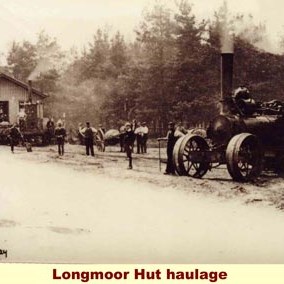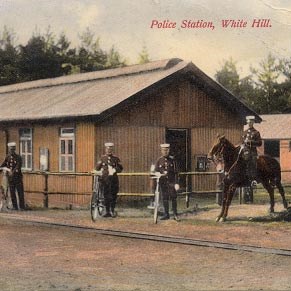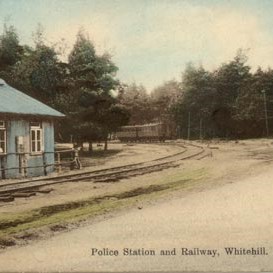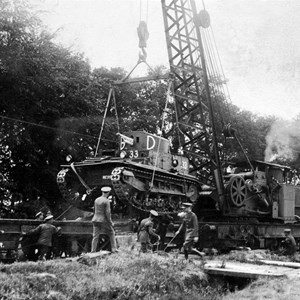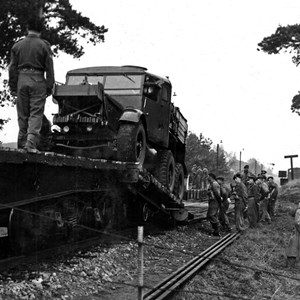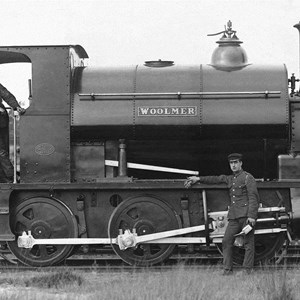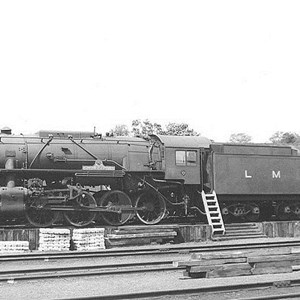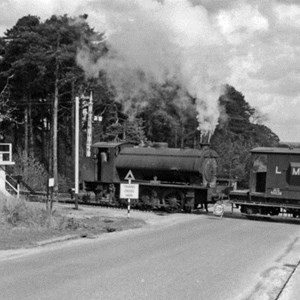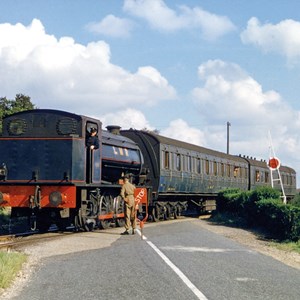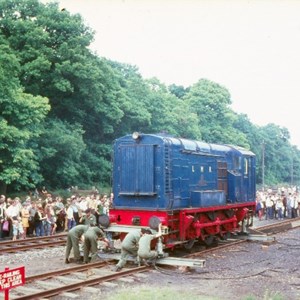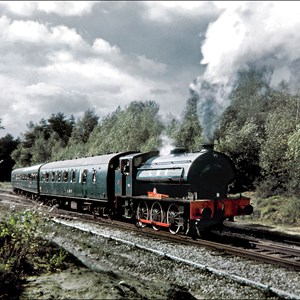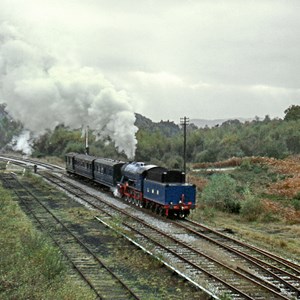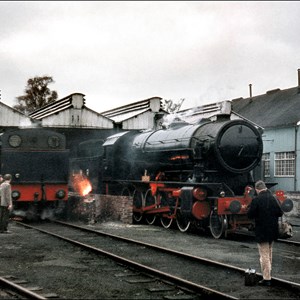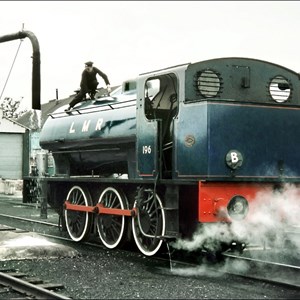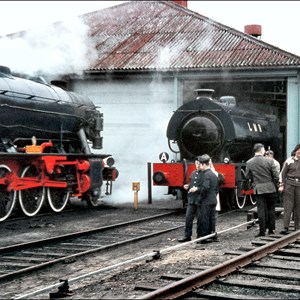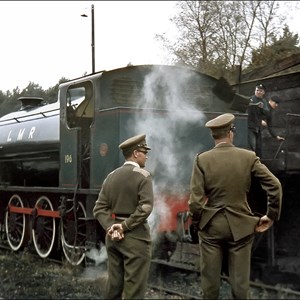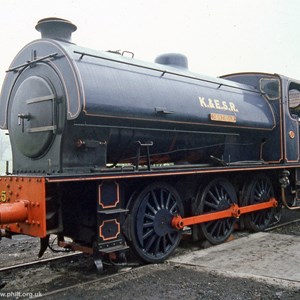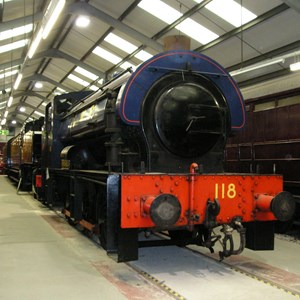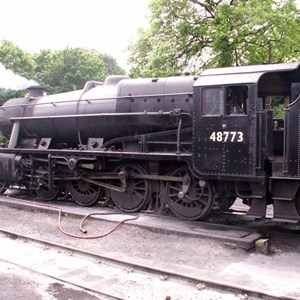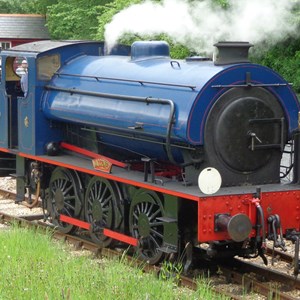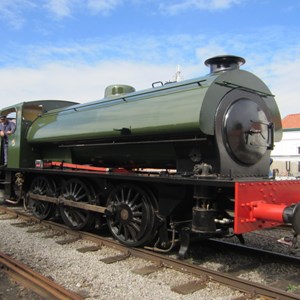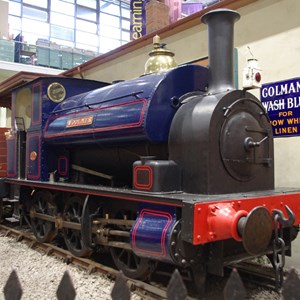Longmoor Military Railway
Woolmer Light Railway
Although the Longmoor Military Railway (LMR) did not connect with Alton, it is worth a mention because it was so unusual. The story starts in 1863 when the Army bought training grounds in the Woolmer Forest near Bordon, requiring soldiers to camp in tents if they stayed overnight. In 1899 the army decided to construct 140 wooden huts, but it was soon clear that the winter ground conditions were not suitable, so in 1903 the 53rd Railway Company of the Royal Engineers were mobilised from Chatham to move 68 huts, each 72ft by 21ft, to Bordon. In order to move them they built a parallel set of narrow-gauge 18inch tracks, set 22ft apart. The huts were raised onto 14 bogie wagons (seven for each side of the hut) using hydraulic jacks and pulled along the tracks using a steam-powered winch. At Whitehill one hut slipped off the bogies and was abandoned, later to be used as a Police Station. The relocation of the huts was completed by 1905 just as the London and South Western Railway opened a short standard gauge branch called the Bentley and Bordon Light Railway (BBLR).
Woolmer Instructional Military Railway
The decision was taken to create a standard-gauge military railway to replace the narrow-gauge lines, so a new route was surveyed to allow for shallower inclines. The new BBLR created a supply route for materials coming from the Army's supply depot at Woolwich Arsenal to build the new line which was given the title Woolmer Instructional Military Railway, opened in 1907. It was for military personnel only and was used both as a form of transport and for training soldiers how to build, run and maintain railways. This was to pay dividends when the First World War broke out, as railways (both narrow gauge and standard gauge) were built all over France to serve the trenches and depots, enabling the fast movement of troops and supplies to the front.
Longmoor Military Railway
It wasn't until 1935 that the railway was renamed the Longmoor Military Railway (LMR), reflected in the 'LMR' initials seen on their locos and rolling stock. The fascinating thing about the Army camps were the names they chose: St. Lucia, Gaudaloupe, Martinique, Louisberg, Vancouver, Quebec, Ottawa, Halifax and Toronto. Many of these barracks had their own stations or sidings, and there were other stations and depots along the line with names such as Apple Pie Sub-depot, Two Range Halt and Heifer's Down to name but a few. Being a military railway, it was not quite like a civilian railway. Signal boxes were called Block Posts, everything was very neat and tidy, and it crossed what are now busy roads (then lanes) on the level with only a soldier on guard to hold back the minimal road traffic when trains crossed.
The other interesting thing about the line was that it was constantly changing. The Army was and is always adapting to current requirements, new technology, reducing budgets or altered encampments, meaning that the buildings and railways were often altered to meet these changing demands. On top of that, the training aspect of the railway meant that the route of certain parts, especially the Hollywater loop, were being altered as trainees leant how to build track, re-rail locomotives, build bridges etc. The Army also had quite a menagerie of locomotives, which like everything else, changed over the years. Many local people were able to see the locomotive collection when the Army held their annual open day for the railway, the last being in 1969 (pictures below), after which the Longmoor Military Railway was officially closed.
Preservation
The closure of LMR coincided with the growing movement of young men who were trying to preserve steam locomotives for posterity; many went on to found preserved railways across the UK. As the page describing the Meon Valley Railway says, having given up on that line as a realistic proposition, attention was turned to the Longmoor Military Railway as a possible site for steam preservation. The huge Longmoor Yard was very appealing for a potential steam centre and when combined with the 1½miles of track connecting it to the main line at Liss, it was a preservationalist's dream. At roughly the same time (1967) the artist David Shepherd had returned home after a successful exhibition in New York with enough money to buy two operational steam locomotives: BR 92203 standard class 9F 2-10-0 and BR 75029 standard class 4-6-0. He then realised that he needed somewhere to store and operate them and that's when he got involved with trying to save the Longmoor Military Railway. Part of the line was leased for a year, but due to local opposition it did not work out and by 1971 all the remaining locomotives had been removed. David Shepherd moved his locomotives to the fledgling East Somerset Railway at Cranmore. It is pleasing to note that at least 9 of the former LMR steam locomotives and 1 diesel were saved including (in order of photos below):
- Gazelle (Dodman & Co. 0-4-2WT) - The Colonel Stephens Railway Museum (Kent & East Sussex Railway)
- LMR 600 2-10-0 Gordon - static exhibit in the 'Engine House Museum' at Highley on the Severn Valley Railway
- WD Austerity 0-6-0 saddle tank 197 'Sapper' - Kent & East Sussex Railway (renamed 'Northiam' No.25) under restoration
- WD Austerity 0-6-0 saddle tank 118 'Brussels' - static display at Oxenhope on the Keighley & Worth Valley Railway
- LMR 500 (Stanier 8F 2-8-0) - Severn Valley Railway
- WD610 General Lord Robertson (Sentinel 0-8-0DH) - diesel loco - Avon Valley Railway, in storage
- WD192 Waggoner (Hunslet Austerity 0-6-0ST) - Isle of Wight Steam Railway
- WD196 Errol Lonsdale (Hunslet Austerity 0-6-0ST) - Maldegem Steam Centre (Stoomcentrum Maldegem, Belgium)
- WD200 (Hunslet Austerity 0-6-0ST) - Colne Valley Railway - under restoration
- Woolmer (Avonside 0-6-0ST) - Milestones Museum (Basingstoke) - static exhibit
For further reading there a number of books you can consult:
Branch Lines to Longmoor by Vic Mitchel and Keith Smith, Middleton Press 1987, ISBN 0 906520 41 X
Woking to Alton by Vic Mitchel and Keith Smith, Middleton Press 1988, ISBN 0 906520 59 2
The Longmoor Military Railway Volume One : 1903-1939
by David Ronald & Mike Christensen, Black Dwarf Lightmoor Publications, ISBN 9781899889693
The Longmoor Military Railway Volume Two : World War Two and the Cold War Era
by David Ronald & Mike Christensen, Black Dwarf Lightmoor Publications, ISBN: 9781899889778
The Longmoor Military Railway Volume Three : The Inevitable Closure, Locomotives & Rolling Stock
by David Ronald & Mike Christensen, Black Dwarf Lightmoor Publications, ISBN: 9781899889891
The Longmoor Military Railway by D W Ronald and R J Carter, David & Charles 1974, ISBN 0-7153-6357-3
Also, there are some interesting websites on the subject:
https://mikemorant.smugmug.com/Trains-Railways-British-Isles/Miscellaneous/Longmoor-Military-Railway/
https://plumbloco.smugmug.com/Trains/Longmoor-Military-Railway/i-9M9Fbsb
https://en.wikipedia.org/wiki/Bordon_and_Longmoor_Military_Camps
http://www.woolmerforest.org.uk/subjects/about.php
The photographs were found on the Internet and the copyright belongs to the respective photographers. Whilst this website and Friends of Alton Station is a not for profit organisation, if any of the copyright holders has any objection to our using their photographs please let us know and we will remove them.
Find out more about the history surrounding Alton's railways on the following pages:
HISTORY Page Index
Introduction: The Railway Comes to Alton
Footbridge History
The Ladies of Alton
Mid-Hants Railway
Basingstoke & Alton Light Railway
Meon Valley Railway
Longmoor Military Railway
Bentley & Bordon Light Railway
Click on these links, or use the drop-down menu above to navigate between the pages.
